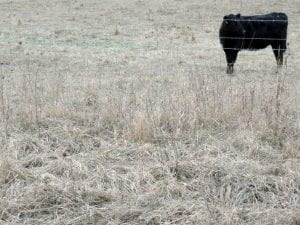by Nancy Glazier

Photo by: Brett Chedzoy, Angus Glen Farms
The time is here for stockpiling pastures. As of today (July 17), conditions in the region are variable. Some areas have received some significant rains while others have missed out. Will we have widespread rainfall in the next few weeks to get pastures growing? I will make the assumption we will.
I’ve written about the concept in the past, but I’d like to look at it from the economics perspective. Legend has been perpetuated stockpiling is cheaper. There is no doubt with feed being the biggest expense, grazing vs feeding hay can save money. There are many variables to consider, though, namely availability of additional acreage and farm owner flexibility. For example, a farm with 15 beef cow calf pairs will need approximately 30 acres for 185-day grazing season. With this scenario, if only 30 acres of pasture are available and hay is purchased, there is no option for stockpiling. If, on the other hand, the farm has access to additional pasture or fenced (or ability to fence temporarily) hay ground, then stockpiling may work. This could be land owned with a cutting of hay taken early.
Some estimations and assumptions are required. On the basis of this small herd example, assuming the calves are weaned and sold, an additional 11.7 tons of feed would be needed for a month for the cows. The number is based on 1300 lb. cow with 4% bodyweight in feed needed. This is a bit high, but a good conservative number and a realistic expectation of grazing stockpiled forage after the first killing frost. There will be loss from trampling, waste and quality decline.
Hay value would be estimated at $100/ton for a total of $1170. This could be purchased or homegrown. If pasture is stockpiled this would require an estimated 16 acres. Rental rates are variable, but I will use $25/acre, since the land would only be needed for three months of the growing season. This would be $400. Water needs to be available, too.
Recommendations for stockpiling call for 60 lbs. of actual N fertilizer in early August. Urea for the pastures would be $350/ton, a ton would do it. If fertilizer is not applied, additional acreage would be necessary. Assuming we get those late summer/early fall rains.
My feeble figures for the above scenario show the stockpiled costs would be about $750, about $420 less than the hay value. These figures do not cover the cost of transporting, moving and feeding hay and assumes any additional fence is already in place. This may be a feasible scenario in parts of our region where marginal land is available for rent or use. This would be an ideal situation where someone else only wanted one cutting earlier in the season. Some farms have the option of moving animals to another location to graze partway through the season, which frees up acreage for stockpiling as well.
As a refresher for stockpiling, strip graze the stockpiled pasture any time after a hard frost. We have no control over the weather, so have a backup feed plan. Fertility should be adequate, if not, apply to soil test reports. Some species will stockpile better than others. We don’t have a lot of tall fescue in our region, but that has the best standability. Other options include orchardgrass, timothy, and bromegrasses. The full article can be found on our website here: https://nwnyteam.cce.cornell.edu/submission.php?id=758&crumb=grazing|4.

